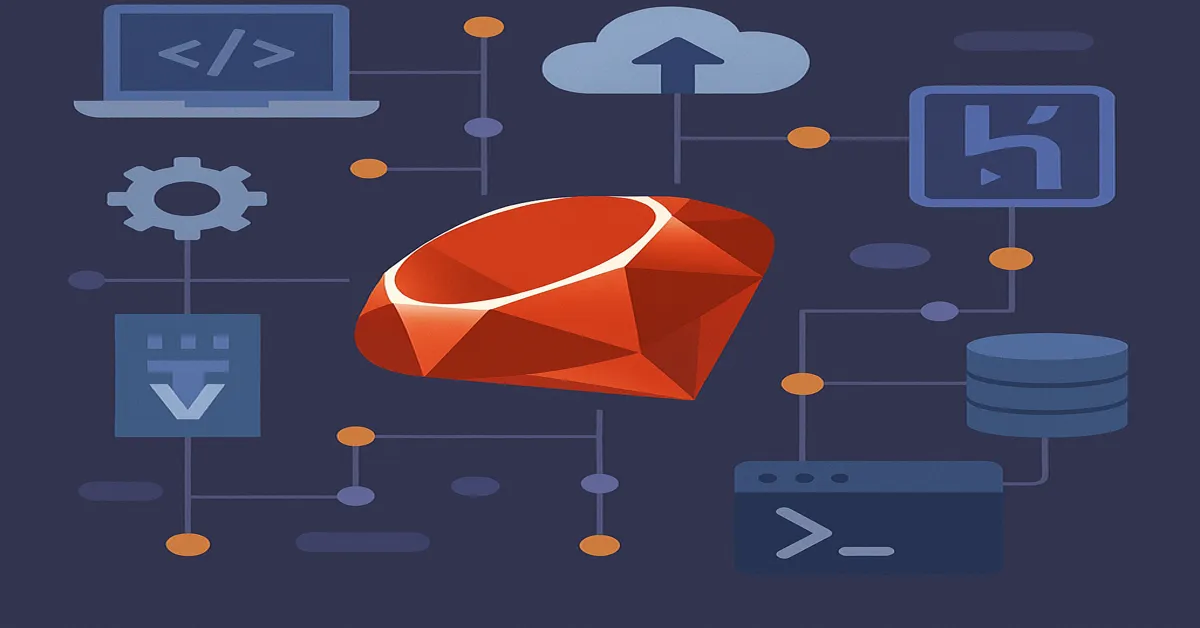In the landscape of software development, where agility and automation define competitiveness, DevOps has emerged not just as a methodology but as a culture. It bridges the gap between development and operations through tools, practices, and collaborative approaches. While many languages dominate DevOps tooling—Python, Go, and Bash being chief among them—Ruby has maintained a quietly influential presence. From infrastructure provisioning to application deployment, Ruby has powered tools like Vagrant, Capistrano, and the Heroku toolchain. This article delves deep into how Ruby is used to build and integrate DevOps tools, exploring both legacy systems and modern evolutions.
Why Ruby in DevOps?
Ruby’s influence in the DevOps space can be traced back to its design philosophy: developer happiness and productivity. With its human-readable syntax and flexible metaprogramming capabilities, Ruby became an attractive option for scripting infrastructure tasks. Furthermore, its vibrant ecosystem and robust testing frameworks made it an ideal language for building and maintaining tools that require reliability and clarity.
Ruby’s early adoption by influential platforms like GitHub and Heroku further cemented its presence in the DevOps world. Many of the foundational tools that DevOps teams still use today—such as Vagrant and Chef—were either written in Ruby or provided Ruby-based DSLs (domain-specific languages).
But the question arises: in a world increasingly favoring Go and Kubernetes-native tools, does Ruby still have a seat at the table? The answer lies not in the trends but in the specific strengths Ruby brings to the DevOps toolchain.
Vagrant: Provisioning Virtual Environments the Ruby Way
Vagrant, developed by HashiCorp, is arguably the most well-known Ruby-based DevOps tool. Designed to create and configure lightweight, reproducible, and portable virtual environments, Vagrant uses Ruby under the hood and exposes a DSL that allows developers to write Vagrantfiles in Ruby.
The Role of Ruby in Vagrant
At its core, Vagrant uses Ruby for configuration and scripting. This allows developers to:
- Define virtual machine configurations in a readable and programmable format.
- Extend Vagrant’s functionality through plugins, which are typically written in Ruby.
- Automate provisioning scripts, integrating with tools like Ansible, Puppet, and Chef.
Example of a Vagrantfile:
rubyCopyEditVagrant.configure("2") do |config|
config.vm.box = "ubuntu/bionic64"
config.vm.network "forwarded_port", guest: 80, host: 8080
config.vm.provider "virtualbox" do |vb|
vb.memory = "1024"
end
end
This configuration script, although simple, showcases how Ruby makes it possible to turn infrastructure definitions into code that is easy to read, modify, and share.
Extending Vagrant
One of Vagrant’s strengths is its extensibility. Through Ruby plugins, developers can hook into Vagrant’s lifecycle—before, during, or after the provisioning process. This makes it ideal for customizing virtual environments for development, testing, or continuous integration.
Heroku: Ruby DNA in Platform-as-a-Service
Heroku, one of the earliest Platform-as-a-Service (PaaS) offerings, was born in the Ruby ecosystem. Initially a platform tailored for Ruby on Rails applications, Heroku’s original toolbelt and CLI were written in Ruby, and the philosophy of convention over configuration permeates its architecture.
Ruby’s Continued Relevance in the Heroku Toolchain
While Heroku’s CLI has since been rewritten in Go for performance and cross-platform consistency, many of the underlying components—especially in the buildpack ecosystem—still lean on Ruby tooling. Developers creating custom buildpacks, for example, often use Ruby scripts to handle application dependencies, environment setup, and process management.
Ruby also powers several add-ons and logging utilities used within the Heroku ecosystem. For teams operating in the Ruby or Rails space, Heroku remains a near-seamless deployment target, with Ruby scripts facilitating everything from asset precompilation to database migrations.
Beyond Vagrant and Heroku: The Ruby Ecosystem in DevOps
While Vagrant and Heroku highlight Ruby’s historical contributions to DevOps, the language’s utility extends beyond these names. Let’s explore several other areas where Ruby continues to play a pivotal role.
Capistrano: Remote Server Automation
Capistrano is a remote server automation and deployment tool that uses SSH to execute commands on remote machines. It was originally built to deploy Ruby on Rails applications, but its flexible nature makes it suitable for a variety of environments.
Capistrano’s deployment scripts are written in Ruby, allowing for high customization. Teams can define tasks, hooks, and stages directly in code, orchestrating deployments in ways that go far beyond simple shell scripts.
rubyCopyEditnamespace :deploy do
task :restart do
on roles(:app) do
execute :touch, release_path.join('tmp/restart.txt')
end
end
end
This kind of declarative deployment scripting, enriched by Ruby’s expressive syntax, enables infrastructure-as-code without the overhead of complex YAML pipelines.
Chef: Configuration Management with Ruby DSLs
Chef, one of the early configuration management tools, uses a Ruby-based DSL to define “recipes” and “cookbooks” for configuring systems. Although tools like Ansible and Terraform have gained popularity, Chef still sees usage in enterprise environments, and its Ruby foundation provides a level of flexibility unmatched by more declarative approaches.
The Ruby DSL in Chef allows conditional logic, loops, and custom functions—making it suitable for dynamic environments where simple key-value configuration files fall short.
Fastlane: DevOps for Mobile Developers
Fastlane is a lesser-known gem in the DevOps space, especially tailored for mobile developers. Built in Ruby, Fastlane automates the release process for iOS and Android apps. It handles tasks such as:
- Code signing
- Building and packaging apps
- Uploading binaries to App Store or Play Store
- Generating screenshots and changelogs
Fastlane scripts, or “lanes,” are defined in Fastfile using Ruby syntax, allowing full customization of the release process.
Modern Use Cases: Ruby in CI/CD Pipelines
In the evolving DevOps landscape, continuous integration and continuous delivery (CI/CD) are no longer optional. Ruby, while not the default language for writing entire CI/CD platforms today, is still used to build supporting tools and plugins.
For example:
- Ruby scripts are often used to validate YAML configurations, manage environment variables, or manipulate file structures in pipelines.
- Many CI tools like Jenkins or GitHub Actions integrate easily with Ruby-based testing tools like RSpec and Cucumber.
- Ruby gems like
bundler-audit,brakeman, andreekare commonly included in security and quality assurance stages.
Designing Your Own DevOps Tools in Ruby
Building DevOps tools in Ruby is not merely about scripting—it’s about creating reusable, modular, and testable software that enhances automation.
Advantages of Using Ruby
- Readable and Maintainable: Ruby’s syntax is close to natural language, reducing cognitive overhead.
- Mature Ecosystem: The RubyGems ecosystem provides a wealth of libraries, from SSH clients to file watchers.
- Strong Community: Although smaller than Go or Python communities in DevOps, Ruby’s open-source contributors are deeply experienced in automation tools.
- Test-Driven Development: Tools like RSpec and Minitest support building robust, testable DevOps software.
Best Practices
- Modularize: Break your tool into reusable classes and modules.
- Use Thor or OptionParser: These libraries help build powerful CLI interfaces in Ruby.
- Integrate Logging and Metrics: Ruby makes it easy to hook into tools like StatsD or Logstash.
- Dockerize: While Ruby scripts can run anywhere, Docker ensures consistency across environments.
Challenges and Considerations
Despite its strengths, Ruby is not without drawbacks in the modern DevOps world:
- Performance: Ruby’s runtime is slower than Go or Rust, making it less ideal for performance-critical applications.
- Concurrency: Ruby’s threading model, particularly in MRI (Matz’s Ruby Interpreter), is limited compared to native threads in other languages.
- Declining Popularity: Fewer new DevOps tools are being written in Ruby, leading to fewer resources and community activity.
However, these drawbacks can be mitigated by leveraging Ruby where it shines—scriptability, integration, and orchestration—not for heavy lifting.
Future Outlook: Is Ruby Still Relevant?
In a world dominated by Kubernetes operators, container-native tooling, and Go-based CLIs, Ruby might seem outdated. But its role in DevOps is evolving rather than disappearing.
Ruby is increasingly being used in niche areas where its expressiveness and developer-centric design are advantageous. Tools like Fastlane and Metasploit (another Ruby-based framework) highlight Ruby’s ongoing relevance in specialized domains.
Moreover, the renewed interest in developer experience (DX) is bringing attention back to languages like Ruby, which prioritize clarity, testing, and community-driven development. As infrastructure grows more complex, having tools that are understandable and maintainable becomes a competitive advantage.
Conclusion
Building DevOps tools with Ruby is not a relic of the past—it’s a strategic choice that emphasizes clarity, maintainability, and developer productivity. While newer languages may offer performance benefits, Ruby offers an unmatched balance of simplicity and power for automating infrastructure, deploying code, and orchestrating systems.
From legacy titans like Vagrant and Chef to modern CI helpers and mobile automation tools, Ruby continues to influence how infrastructure is managed. For developers considering building or extending DevOps tooling, Ruby remains a compelling choice—especially when the goal is not just automation, but sustainable automation.
Read:
Ruby vs Python in 2025: Which One Should You Learn for Web Development?
Hotwire Integration with Rails 7+: The Future of Full-Stack Ruby
CVE‑2025‑43857 in net‑imap: What Ruby Developers Need to Know
How to Fix Common Ruby Gem Installation and Configuration Issues
Is It Still Worth to Learn Ruby in 2025?
FAQs
1. Why should I choose Ruby for building DevOps tools over other languages like Python or Go?
Ruby excels in readability, rapid development, and ease of scripting. While Go and Python are popular in modern DevOps, Ruby’s expressive syntax and powerful DSL capabilities make it ideal for tools that require customization and flexibility. It’s particularly effective when building CLI tools, deployment scripts, or infrastructure automation with a strong developer focus.
2. Is Ruby still relevant in DevOps given the rise of Kubernetes and container-native tools?
Yes, Ruby remains relevant, especially in areas where readability, testability, and ease of use matter. While Kubernetes-native tooling is often written in Go, Ruby still powers critical tools like Vagrant, Fastlane, and parts of Chef. It’s also frequently used in scripting, custom plugins, and in Rails-focused environments where teams prefer a consistent stack.
3. Can I use Ruby to create plugins or extensions for existing DevOps tools like Vagrant or Chef?
Absolutely. Both Vagrant and Chef are designed to be extended via Ruby-based plugins and modules. Vagrant offers a plugin architecture built entirely in Ruby, while Chef’s infrastructure is defined through Ruby DSLs. This makes it easy to create custom behaviors, integrations, and environment configurations using Ruby code.
4. What libraries or frameworks should I use to build a DevOps CLI tool in Ruby?
To build a CLI tool in Ruby, popular libraries include:
- Thor – A toolkit for building command-line interfaces.
- OptionParser – Built-in Ruby class for parsing command-line options.
- TTY – A collection of components for building beautiful and robust CLIs.
These libraries help create user-friendly, testable, and modular command-line tools suitable for DevOps workflows.
5. How does Ruby integrate with modern CI/CD pipelines like GitHub Actions or GitLab CI?
Ruby integrates seamlessly with modern CI/CD platforms. You can:
- Run Ruby scripts to automate tasks in pipeline stages.
- Use Ruby gems like
bundler-auditorrspecfor testing and security checks. - Define jobs and workflows that execute Ruby-based tools or commands.
This makes Ruby a practical choice for scripting and validation tasks in automated delivery pipelines.











